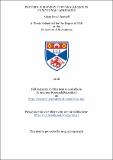Files in this item
Pattern discovery for parallelism in functional languages
Item metadata
| dc.contributor.advisor | Hammond, Kevin | |
| dc.contributor.author | Barwell, Adam David | |
| dc.coverage.spatial | x, 194 p. | en_US |
| dc.date.accessioned | 2018-07-23T10:49:37Z | |
| dc.date.available | 2018-07-23T10:49:37Z | |
| dc.date.issued | 2018 | |
| dc.identifier.uri | https://hdl.handle.net/10023/15641 | |
| dc.description.abstract | No longer the preserve of specialist hardware, parallel devices are now ubiquitous. Pattern-based approaches to parallelism, such as algorithmic skeletons, simplify traditional low-level approaches by presenting composable high-level patterns of parallelism to the programmer. This allows optimal parallel configurations to be derived automatically, and facilitates the use of different parallel architectures. Moreover, parallel patterns can be swap-replaced for sequential recursion schemes, thus simplifying their introduction. Unfortunately, there is no guarantee that recursion schemes are present in all functional programs. Automatic pattern discovery techniques can be used to discover recursion schemes. Current approaches are limited by both the range of analysable functions, and by the range of discoverable patterns. In this thesis, we present an approach based on program slicing techniques that facilitates the analysis of a wider range of explicitly recursive functions. We then present an approach using anti-unification that expands the range of discoverable patterns. In particular, this approach is user-extensible; i.e. patterns developed by the programmer can be discovered without significant effort. We present prototype implementations of both approaches, and evaluate them on a range of examples, including five parallel benchmarks and functions from the Haskell Prelude. We achieve maximum speedups of 32.93x on our 28-core hyperthreaded experimental machine for our parallel benchmarks, demonstrating that our approaches can discover patterns that produce good parallel speedups. Together, the approaches presented in this thesis enable the discovery of more loci of potential parallelism in pure functional programs than currently possible. This leads to more possibilities for parallelism, and so more possibilities to take advantage of the potential performance gains that heterogeneous parallel systems present. | en_US |
| dc.language.iso | en | en_US |
| dc.publisher | University of St Andrews | |
| dc.subject.lcc | QA76.58B2 | |
| dc.subject.lcsh | Parallel processing (Electronic computers) | en |
| dc.subject.lcsh | Pattern recognition systems | en |
| dc.subject.lcsh | Computer algorithms | en |
| dc.title | Pattern discovery for parallelism in functional languages | en_US |
| dc.type | Thesis | en_US |
| dc.contributor.sponsor | Seventh Framework Programme (European Commission) | en_US |
| dc.contributor.sponsor | European Cooperation in Science and Technology (COST) | en_US |
| dc.contributor.sponsor | Engineering and Physical Sciences Research Council (EPSRC) | en_US |
| dc.type.qualificationlevel | Doctoral | en_US |
| dc.type.qualificationname | PhD Doctor of Philosophy | en_US |
| dc.publisher.institution | The University of St Andrews | en_US |
This item appears in the following Collection(s)
Items in the St Andrews Research Repository are protected by copyright, with all rights reserved, unless otherwise indicated.

